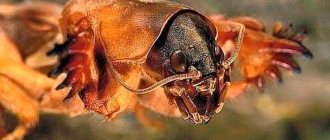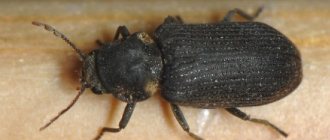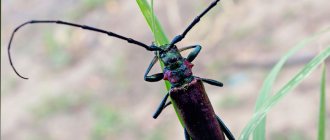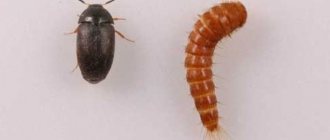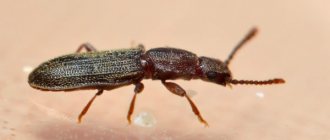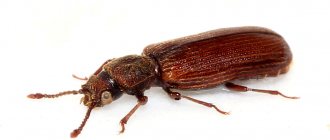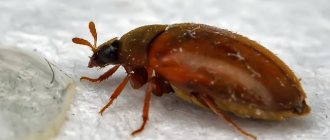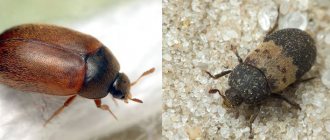Photo: poradum.com.ua Wireworms are not such a “well-known” enemy of the garden as ants or Colorado potato beetles. They are quite inconspicuous, difficult to detect and not everyone knows who they are. But the losses from wireworms are more than enough, because when they finally catch your eye, the chances of saving the plant are almost zero. We have collected all the best folk remedies to get rid of wireworms in the garden!
Wireworms in the garden: why are they dangerous?
First, let's figure out who wireworms are, because they are still so little studied. In fact, this is not a separate insect, but the larvae of click beetles. Adults eat mainly cereal leaves and are not too dangerous. During the season, one female lays several hundred eggs, but much more voracious wireworm larvae hatch from them.
Wireworm is the main threat to gardens, because it is, without exaggeration, omnivorous. On their way, the larvae sweep away potatoes, beets, tomatoes, cabbage, radishes - and that's not all. They are completely indifferent whether they are tubers or sprouts, only sprouted seeds or mature plants. During the season, in the most advanced cases, wireworms can destroy up to 75% of the crop.
Photo: poradum.com.ua
What crops does the pest affect?
Wireworms damage the seeds and underground parts of many vegetable and ornamental plants.
Potato tubers, dahlias, gladioli, beet roots, carrots, strawberry roots, corn, daffodil bulbs, tulips, and iris rhizomes are subject to their invasion . Wireworms can chew through tomato .
Wireworm in potatoes
Wireworm in potatoes
Potatoes are the wireworm's favorite vegetable. Together with the Colorado potato beetle, these are the main crop pests. Once settled in a potato plot, wireworms can damage up to 60% of the tubers. Juicy potato roots are also a source of food for beetle larvae. Because of this, nutrition in the bushes is disrupted and the tuber yield is reduced.
Fungi, bacteria and nematodes settle through holes in the pulp. Damaged tissue around the passages turns black, and the tubers become inedible.
How to detect wireworms
Noticing wireworms is very problematic, because the larvae hide in the ground and reluctantly crawl to the surface. Usually, you can find out that the tubers have been mercilessly eaten only at the harvest stage. In the best case - during hilling or loosening the soil.
Sometimes you can suspect the appearance of voracious parasites by the presence of adult individuals. But not everything is so smooth with them, because in appearance they are very similar to harmless ground beetles. So you will have to listen to see if the beetles make characteristic clicks during activity.
Photo: krasivosti.pro
If at least once you come across potatoes dotted with winding passages, this is the work of a wireworm. In the early stages, it is indicated by dark spots and blackheads.
The only saving grace is that the larvae move very slowly from bush to bush, because they cope better with vertical passages. This gives a slight head start and the possibility of losing a couple of plants, and not the entire bed.
Photo: liveinternet.ru
Diseases of currant leaves: descriptions with photos, treatment
Rating of the most effective drugs
If there are a lot of wireworms and you need to eliminate them quickly, the easiest way is to use agrochemicals. Various anti-wireworm preparations for potatoes are popular among gardeners; they have different compositions and principles of action, but many of them are equally effective.
Despite the fact that the means used may be different, the processing process looks approximately the same: put a film on the floor or a flat surface, and lay the tubers on it in one layer. Prepare a pickling solution, pour it into a spray bottle, spray the tubers so that the liquid wets their entire surface. When they are dry, turn them over to the other side. Repeat processing.
The second option: make a solution, pour it into a large container, place the tubers in a mesh and lower it into the liquid. Leave for the time indicated in the instructions. Then dry it by spreading it in one layer in a dry room. Treatment with products should be carried out on the day of planting.
Taboo
Systemic insecticide-protectant for tubers and plant seeds. Protects crops during the period when they are most vulnerable - in the seedling stage. It has a long validity period – up to 1.5 months. The drug is available in the form of a water-suspension concentrate; according to the manufacturer, it is effective regardless of environmental conditions, that is, in any weather. How to use: spray the tubers ready for planting or, alternatively, the soil in the furrows when planting. One treatment is enough, but it should be carried out no later than 3 months before digging up the tubers - that is how long the waiting period for the drug lasts.
Prestigator
This is a suspension concentrate intended for treating tubers before planting. It can be combined with antifungal agents and growth stimulants. When planting the treated tubers, you can fertilize them with fertilizers; the drug does not compete with them.
Prestigitator protects potatoes throughout the growing season; the time for complete decomposition of the active ingredients is 2 months. In this regard, it cannot be used on early varieties.
Zemlin
The drug fights not only wireworms, but also mole crickets. Time of use – dressing of planting tubers in spring and autumn preventive tillage. The insecticide is mixed with sand and this anti-wireworm agent is applied when planting in holes or granules are scattered over the area. The validity period of Zemlin against wireworm is 2 months, so for most varieties one treatment is usually sufficient.
Prestige
One of the most famous insecticides. They are used to treat the tubers before planting. It protects not only from wireworms, but also from another dangerous enemy of nightshades - the Colorado potato beetle. It has a fungicidal effect and protects against fungal infections. It increases germination, strengthens the immune system, and plants treated with it can more easily withstand changing weather conditions. Combines with growth stimulants and complex fertilizers. Protects potato bushes from wireworms throughout the entire period of their growth. Restriction on the use of Prestige: not suitable for early varieties.
Zarit
In addition to wireworms, it destroys mole crickets. The granules are laid out on the site or buried in the ground to a depth of 5-10 cm.
Initiative
Microgranules of poison are embedded in the soil, evenly distributing them in it, which ensures the necessary contact with pests. Destroys them within 24 hours, valid for 1.5 months. Pochin is not phytotoxic; it cannot be mixed with other agrochemicals.
Chops
The drug is a ready-made bait for poisoning pests. These are granules that are evenly embedded in a layer of earth at a depth of 5-10 cm. Rubit should not be mixed with fertilizers or any medications. The insecticide is non-toxic for plants.
Barguzin
Barguzin is available in the form of emulsion concentrate and granules. According to the instructions for use, its effect is noticeable within 3-4 days after treatment - application to the soil when planting or detecting wireworms. Protects plants for more than 3 weeks, which is quite enough at the initial stages of their growth. It is non-toxic for all types of plants and is compatible with many agrochemicals of different classes.
Provotox
To kill the pests, a single application of Provotox against wireworms in the holes during planting is sufficient. You can distribute it over the entire area of the beds, embedding the granules to a shallow depth. It is not recommended to use the insecticide on early varieties of potatoes and mix it with other agricultural products.
Mechanical wireworm traps
Banal mechanical traps work well against voracious larvae. We offer several proven options:
— Bury jars of chopped potatoes and carrots near the wireworm-infected bed. Cover the neck with foil and cut small holes so that beetles and larvae can get in, but cannot get out;
— String the remains of the old crop on a wire and dig it into the ground, leaving the end outside. After three days, pull the vegetables by the wire and destroy them along with the larvae;
— Adult beetles can be lured by a pile of manure or freshly cut grass;
— Generously pour sawdust soaked with insect poison into a glass jar. Dig the jars into the ground up to the neck in different places between the beds;
- Soak old and spoiled potato tubers in insecticide for a day and scatter them over the garden bed, adding a little bit. After a few days, replace the trap with a new one until the wireworms disappear from the garden.
Photo: beztarakanov.ru
What soils does wireworm like?
The number of pests is affected by soil moisture and salt concentration in it. Most species living in the central regions do not tolerate moisture deficiency well. Only steppe species are more resistant to fluctuations in soil moisture. During drought they go deep into the earth.
Click beetle larvae love acidic soils overgrown with weeds. In such places there is always a lot of food for them. Of the weeds, the most favorite are wheatgrass, quinoa, and thistle.
In saline areas, pests feel worse, since particles of ammonium, potassium and sodium damage their chitinous covers.
Thanks to its ability to migrate deep into the ground, the wireworm hides from harmful high temperatures and frosts. Although in the central regions the pest can survive for several days when the temperature drops to -6 to -10°C.
The wireworm prepares for wintering in advance. Within 2 months, the volume of water in the body decreases and the amount of glycogen increases.
Simple folk remedies for wireworms
Folk recipes do a good job if you manage to detect the wireworm in time. They are the most environmentally friendly and safe for any seedlings, so it’s worth starting with them.
— When planting tubers, pour a little mustard powder with hot chili pepper into each hole;
— Add crushed onion peels into the holes - it repels many pests. And then periodically steam it with water, cool it and use it for watering;
— Pour half a kilogram of fresh nettle and 200 g of dandelions into a bucket of water. Let the liquid sit and water the potato beds every three days for a week and a half;
— Place several spruce or pine branches into the holes so that the soil is saturated with essential oils of pine needles;
- If the plants are already affected, water them with infusion of celandine. Brew 100 g of crushed flowers and let it brew for three days;
— Scatter crushed eggshells over the beds where pests have settled.
Photo: da4a-klya4a.ru
Snowdrops (50 photos): types, planting and care in open ground
Signs of parasitism on vegetable and fruit crops
The wireworm is an underground dweller. It can be discovered when digging up an area, when the larvae are thrown to the surface.
Secondary signs:
- The seeds do not germinate. When the holes are dug out, damage is visible.
- The seedlings are withering. The parasite eats up young roots, preventing the plant from developing.
- On root crops and potatoes, subtle movements made by the pest are noticeable.
It is difficult to detect wireworms in plantings of potatoes and root crops without tilling the soil or digging up the fruits. The larvae eat individual bushes without going far, and there is practically no permanent damage. Affected plants wilt. Pests are also noticed when loosening the beds, when they appear on the surface.
The peculiarity of wireworms is that they move vertically in the soil, but only slightly in the horizontal direction.
Chemicals
These are more aggressive methods of combating wireworms in the garden, but sometimes you cannot do without them. Be sure to use protective equipment: gloves, goggles, respirators.
— When planting tuberous crops, treat each onion with approximately 250 ml of manganese solution, 2-4 g per bucket of water;
— Some mineral fertilizers “displace” wireworms a couple of meters deep into the ground. There they no longer reach the crops. You will need approximately 30 g of ammonium nitrate or ammonium sulfate per square;
— Superphosphates treated with insecticides have proven themselves well. This is a more gentle method compared to using poisons directly. First, spray the fertilizers and let them dry on the film, and then apply them to the soil at a rate of about 5 kg per 100 square meters;
- As a last resort, use ready-made store-bought insecticides against wireworms in their pure form. Be sure to strictly follow the proportions and dosages on the label, because most of these substances are real poisons.
Photo: zen.yandex.ua
Wireworm pest - description
Wireworms are the larvae of a small, up to 15 mm, click beetle. There are many types of different insects, some of which are very dangerous for crops. The larvae of dark and striped beetles damage cereals and sunflowers. Wireworms of black click beetles and tussocks harm vegetables and potatoes. Adult insects themselves are not dangerous to the crop.
Appearance and stages of development
A description of the wireworm will help you recognize the pest. The larvae got their name from their elongated thin body, similar to a wire, 1.5–4.5 cm long. It is difficult to crush the pest, the chitinous cover is so hard. The segmented body has 3 pairs of legs.
Interesting! The literal translation of the name of the beetle larvae from English and German is “wireworm.”
The beetle completes its development in 5 years:
- In May–July, female wireworms lay eggs. Place in piles of 3–5 pieces in cracks in the soil, under lumps, and weeds.
- Larvae appear on average after a month. In the first year of life they are inactive, feeding on the roots of weeds in the place where they hatched.
- The wireworm is dangerous from the second year. Becomes highly active, eats a lot, and grows quickly. From now on, the main food of the larvae is cultivated plants. They look like worms with a chitinous covering of yellow or light brown color.
- The larval stage lasts up to 4 years. Then the grown individual pupates, and the adult beetle emerges in the spring.
Suitable Habitat
There are many types of beetles, pests have adapted to different conditions and live almost everywhere. They choose heavy clayey, moist soils; if such conditions do not exist, they live in any soil. The larvae can be found in the spring almost at the top of the soil, in the summer - their passages are at a depth of 10–20 cm. During drought, they look for moisture and go vertically down. They overwinter, burrowing half a meter into the soil. Pests prefer areas not heated by the sun.
The favorite habitats of wireworms are moist, uncultivated soil overgrown with weeds. They almost always live in fields with creeping wheatgrass, clover, and cereal crops. Pests remain in a young, recently planted garden at the dacha, in new beds after herbs.
In areas with ideal conditions, there are many larvae - from one-year-olds to adults ready to pupate. Continued development helps to completely get rid of wireworms in the garden in 2–3 years. It does not like cultivated land and begins to die en masse.
Reproduction and distribution of insects
From the eggs laid by the female beetle in May–July, under favorable conditions, larvae appear a month later. From one individual to 150. They grow for 3–4 years and overwinter several times. In August, adult larvae turn into pupae, in the spring beetles fly out of them, and the cycle repeats.
It is difficult to remove wireworms from the garden forever for the following reasons:
- numerous offspring from one female - up to 150 larvae;
- longer lifespan compared to other insects;
- underground hidden life.
The larvae have increased vitality due to their rigid body, wintering at a depth of up to 0.6 m. In the spring, with the onset of warmth, adult beetles fly to new areas. Many species, during a period when there is little food, eat leaves, needles of trees, bushes, and feed on pollen.
Other methods of controlling wireworms
In the case of wireworms, the “all means good in war” method works 100%. Therefore, we learned a couple more effective tricks needed in the difficult struggle for the vegetable garden.
- Attract birds to the site - crows, wagtails, rooks, starlings, thrushes and tits - they willingly eat click beetles and their larvae. Leave feeders and treats for the birds;
— Reduce soil acidity using eggshells, bone meal or ash;
— Plant plants between the beds that repel wireworms. These are mustard, spinach, lupine, buckwheat, rapeseed, sweet clover, dahlias and any legumes;
— If nutcrackers have settled in the garden bed, next year plant resistant crops there: pumpkin, greens, cereals or beans;
— Seasonal digging of the soil should be carried out especially carefully and deeply, because in the warm season the larvae get closer to the surface. And be sure to carry out deep digging before frost to destroy the wireworm, which has already laid down for the winter;
— Before planting potatoes, sow the bed with cereal or corn seeds. During this time, the wireworm will come out for new food - and you will destroy the larvae along with the first planting.
Photo: mastergrad.com
Castor bean (50 photos): types, care and planting in open ground
Signs of wireworm appearance
Finding out whether there is a wireworm in the garden is sometimes very difficult. The larva itself is small in size and is not always visible. However, when digging and planting, you need to carefully inspect the soil and if you come across yellow elastic worms, mercilessly destroy them and take further measures to protect the garden from the pest.
Another indicator is the lack of germination of seeds of many crops, especially if the seeds are good and the conditions for growth are suitable. For example, the wireworm happily gnaws the seeds of corn and pumpkin crops.
Well, the most striking indicator is the detection of numerous wormholes on tubers and root crops. Wireworms are very visible in carrots and potatoes. Around its passages, vegetables begin to rot, which significantly reduces the yield.
In the photo below we can see the results of the wireworm's activity.
Wireworm damage to potatoes
Prevention from wireworms in the garden
Getting rid of insatiable larvae is very difficult, and usually you have to combine all possible methods at once. Therefore, it is better to do everything from the beginning to avoid the appearance of wireworms.
— Always weed, get rid of burdocks and “garbage” plants. They become a comfortable and cozy habitat not only for click beetles, but also for other pests;
— Control the acidity of the soil and add alkaline additives in a timely manner. If more and more ferns, horsetail, sorrel or plantain appear among the weeds, this is a sure signal that it’s time to change something;
— During harvesting, remove it completely - and only then you will deal with the presentation and quality of the fruit. Don't leave bad potatoes or carrots to rot in the garden. You think that you are leaving fertilizer for the soil, but in reality you are storing winter supplies for parasites;
- Rotate the seedlings every season. This is called crop rotation - alternating crops on one field and the most important stage in any farming. This improves the properties and nutritional value of the soil, prevents erosion, the spread of weeds and diseases.
Photo: zen.yandex.ru
Did you like the post? Subscribe to our channel in Yandex.Zen, it really helps us in our development!
What is used for preventive treatments?
You can reduce the likelihood of beetles appearing on your site and stop their reproduction if you follow simple rules of agricultural technology: change the types of crops, do not plant the same ones constantly in one place. Do not plant carrots, daikon, or beets in infested beds - crops that are also targeted by click beetles.
Destroy weeds where wireworms like to live - wheatgrass, chicken millet, sedge. In the fall, it is good to dig up the soil, turn the earth over so that the insects end up on top and freeze in the cold. Apply nitrogen fertilizers and ash to the soil, and monitor the acidity of the soil. Plant calendula and marigolds next to potato beds and between rows; their scent should repel pests.
If you decide to grow potatoes, you need to take care of protecting them from wireworms before planting. You should purchase any drug produced by industry, or use a folk remedy.
Source
Agricultural technology guarding the garden
In the fall, it’s time to sow green manure, which will enrich the soil with nitrogen and phosphorus and repel the pest.
Table: green manure against wireworms
| Green manure | Peculiarity | When to sow | Usage |
| White mustard, rapeseed | Essential oils disinfect the soil | September-early October | Dig in shoots 10 cm high |
| Annual lupine | Deoxidizes the earth; nodule bacteria suppress wireworm activity | In early September | After 45–50 days, mow and dig up |
| Phacelia | Neutralizes, loosens, disinfects soil | All September | Seal for digging after 40 days |
| Rye | Loosens the soil | Before winter | Digging up spring shoots |
Autumn planting of green manure for a long time discourages wireworms from “walking” in this area
Mechanical techniques
At the end of the season, the area is carefully cleared of plant debris both on the soil surface and in the ground. This is especially true for potatoes the size of peas; wireworms flock to them like moths to a light. Waste is burned off-site if it is to be used for traps.
The land is cleared of weeds - milkweed, burdock, sow thistle, woodlice, wheatgrass. They do not tear the plants, but dig them up, selecting the roots where the wireworm lives.
Wheatgrass roots look like a jungle where wireworms happily live
Until the larvae lie “at the bottom” to spend the winter, on the eve of frost the area is dug up with a shovel, turning over clods of earth. If there are pests, then 70–90% of them are guaranteed to be gone. During routine work in the garden: hilling, planting and replanting, the wireworm is picked out by hand; fortunately, its color catches the eye.
The bright, glossy chitinous shell of the wireworm is visible to the naked eye even against a variegated background.

